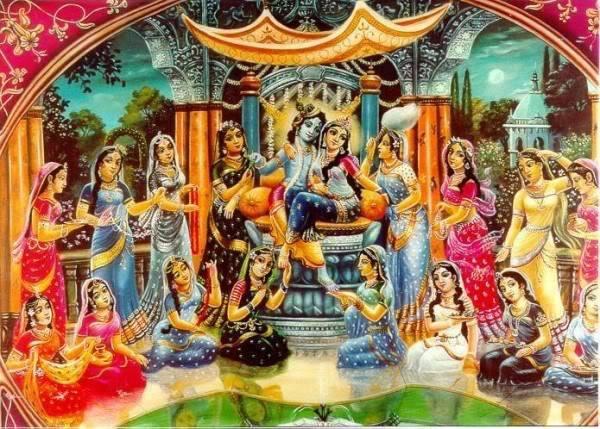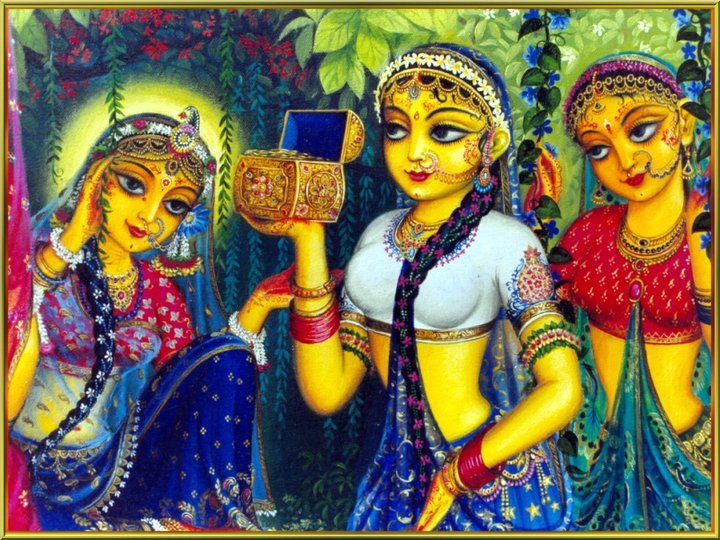Mahanidhi Madan Gopal Das
The famous 64 arts and talents, which Krishna and Balarama mastered in two months at Gurukul, are mentioned in many shastras, including Srimad Bhagavatam (10.45.35-36); Brahma-samhita (37 tika); Bhakti-rasamrita-sindhu (2.1.84); Vrindavan Mahimamrita (11.69,13.4); Govinda-lilamrita (13.1140; and Sadhana Amirta Chandrika (19), catuh-shashthi-kalanvitam.
Srila Prabhupada: “Srimati Radharani makes Krishna happy in so many ways with the sixty-four arts i.e. dancing, cooking, making peace, and smiling in many attractive ways.”
(BBT folio: Discussions, Syamsundar das)
Our Gaudiya Vaisnava Goswamis and acharyas explain how Srimati Radharani’s intimate, sweet and loyal, most loving dasi serving maids, Her dearest kinkaris and manjaris, pleasantly serve Priya-Priyatam with 64 different arts and talents.
The manjaris learn these 64 arts directly from Srimati Radharani and Her sakhis. In the next para, Sri Raghunatha Dasa Goswami mentions a few of the arts that the sadhana siddha manjaris will learn after arriving in Bhauma Vrindavan to serve Sri Sri Radha and Krishna.
- Radharani Herself will personally and repeatedly teach (gandharva –asakrt- shikshayati) four arts to the nava dasis: drama/play writing, poetry, riddles and vina, kavyam-nataka-prahelli-vina.
- Vishakha will teach the art of telling clever, tasteful and funny jokes, narma.
- Champakalata will teach how to cook amazing feasts.
- Citra-sakhi will teach painting pictures on Radha-Krishna, citra.
- Tungavidya will teach 18 different kinds of knowledge and science, vividha vidya.
- Rangadevi will teach how to dance in rasa-lila, natana.
- Sudevi will teach the art of playing dice and advising Radha in defeating Krishna. (Stavavali, Sva Sankalpa Prakash Stotram 2-11)
Next we will list the basic 64 arts. For the Sanskrit names and more elaborate descriptions, please refer to KRSNA BOOK or our book “Gayatri Mahima Madhuri” (cp. 7 pg. 100-102).
The most amazing point about the 64 arts is that every Gaudiya Vaisnava following Sri Caitanya’s path of raga bhakti, will some beautiful fine day in the future go directly to Radha-Krishna’s Bhauma Vrndavana lila, and then learn all these wonderful skills and talents DIRECTLY FROM SRI RADHA and Her dearest sakhis.
In a divine passage, Sri Raghunatha Dasa Goswami reveals how one day in Varshana, Sri Radha holds a nava dasi’s hand and takes her alone into a cave in Govardhan to personally teach Her own love poem. Later in the nikunja on Radha’s signal (ingite), the fortunate manjari will recite Radha’s prema-filled poem for the ecstatic pleasure of Her Priyatam.
This is definitely the ultimate Guru/Shishya sambandha!
THE SIXTY-FOUR ARTS
1-Architecture
2-Arguing with adi-vasis
3-Bed covers, pillow making
4-Bird training for sports
5-Body ornaments, jewellery placing
6-Cakes, bread, salad making
7-Carpentry
8-Children’s games
9-Cloth, hiding quality, cheap look good
10-Conversation
11-Costumes, make and store
12 Crossbreeding plants, trees
13-Crossword puzzle solving
14-Dancing
15-Decorating, hanging pictures
16-Dialects, speaking different
17-Dictionary using
18-Disguise
19-Drama writing
20-Drinks, with red color making
21-Dyeing cloth
22-Earrings, flowers, leaves making
23-Embroidery
24-Face, body painting
25- Flower asanas, beds making
26-Gemstone dyeing
27-Hair care, dressing
28-Hand, sleight of, magic tricks
29-Hypnosis
30-Jewel testing
31-Jokes telling
32-Jugglery, magic
33-Kavaca making
34-Marionettes using
35-Metallurgy
36-Mineralogy
37-Miniture carts making
38-Mystical charms, casting
39-Others, respecting, glorifying
40-Painting, drawing
41-Parrots, train to speak
42-Pathways, cover with flowers
43-Perfumes, make and apply
44-Playing musical instruments
45-Plays, acting in
46-Poetry, mentally compose
47-Rangoli making
48- Recite books
49-Riddles, make, solve
50-Rites, rituals performing
51-Sign language using
52-Singing
53-Skin care
54-Splashing water
55-Stringing necklaces and flowers
56-Tongue twisters
57-Thread making on spinning wheel
58-Turbans, topknots, crown making
59-Victory, attaining
60-Vina, drum playing
61-Wagering
62-Water music making
63-Weapons, bows, arrows, big sticks making
64-Yantra making
Sri Radha teaching arts to manjaris ki jai!
Jai Jai Sri Radhe!


